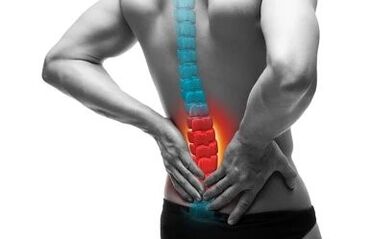Osteochondrosis is a degenerative disease of articular cartilage tissue that can be localized in all joints, as well as in the intervertebral discs. The name of the disease comes from the Greek words meaning “bone” and “cartilage”.Osteochondrosis arises from a physiological (i.e. normal, intended by nature) weakening of the nutrition of the intervertebral discs.This means that the cartilage tissue regenerates poorly, even after minor injuries.In addition, most people, especially those who lead a sedentary lifestyle, unevenly strain their back muscles by staying in one position for a long time at work, talking on the phone for a long time with their ear pressed to their shoulder, carrying bags on one shoulder and using mattresses and pillows that are too soft.
The name of the disease comes from the Greek words meaning “bone” and “cartilage”.Osteochondrosis arises from a physiological (i.e. normal, intended by nature) weakening of the nutrition of the intervertebral discs.This means that the cartilage tissue regenerates poorly, even after minor injuries.In addition, most people, especially those who lead a sedentary lifestyle, unevenly strain their back muscles by staying in one position for a long time at work, talking on the phone for a long time with their ear pressed to their shoulder, carrying bags on one shoulder and using mattresses and pillows that are too soft.
Causes of osteochondrosis
Almost all middle-aged and older people are at risk of developing osteochondrosis of the spine, since the processes leading to the degeneration of cartilage tissue are completely natural.Risk factors and causes of osteochondrosis in more pronounced forms are:
- flat feet;
- obesity;
- heavy physical activity;
- physical inactivity;
- heredity;
- Spinal injuries.
Previously, it was believed that osteochondrosis of the spine manifests itself mainly after the age of 35, but recently patients aged 18-20 have been complaining of back pain caused by osteochondrosis.The likely reasons for the prevalence of osteochondrosis in young people are not only a sedentary lifestyle, but also frequent stress and poor posture.
Manifestations of osteochondrosis are pain and limitation of movement
There are osteochondrosis of the cervical spine, osteochondrosis of the thoracic spine and osteochondrosis of the lumbar spine.But regardless of the type of illness, a person always complains of pain.Where on the back it manifests itself and whether it radiates into the limbs depends on the location, i.e. on which part of the spine the degenerative processes took place.Pain can have various causes, for example pinched (compressed) nerve roots or herniated discs.A herniated disc is a rupture of the fibrous ring and a protrusion of the disc nucleus, i.e. the cartilage tissue itself. In many cases, herniated discs occur precisely against the background of osteochondrosis.
Men and overweight people are much more likely to suffer a herniated disc than others
Pain in osteochondrosis can vary not only in intensity, but also in localization.With osteochondrosis of the cervical spine, pain occurs not only in the neck, but also in the shoulder and radiates to the arm.
Sometimes patients suffer from headaches and dizziness.
Osteochondrosis in the thoracic spine sometimes “mimics” pain in the heart.It can intensify with various movements, be sharp or pulling.With osteochondrosis of the lumbar spine, the pain can radiate to the leg.When a disc herniates, the limbs sometimes feel numb, as if they were being “taken away.”Lower back pain significantly limits freedom of movement and can affect the functioning of internal organs.
Herniated discs occur primarily in the cervical and lumbar spine, and much less often in the thoracic spine.
Complications of osteochondrosis and its treatment
This disease of the spine is associated with pain, so treatment of osteochondrosis is necessary to eliminate or significantly reduce it, thereby increasing the quality of life.The question of how to cure osteochondrosis causes a lot of controversy.The process of treating osteochondrosis is very lengthy;It is associated with the restoration of spinal structures and strengthening of the back muscles and, if indicated, with the surgical treatment of herniated discs.All this time it is necessary to fight pain, since the cause of the disease - degenerative phenomena in the tissue of the articular cartilage - is irreversible and can mainly affect the surrounding tissue.Physiotherapy, massages and swimming improve blood circulation and strengthen the muscle corset.However, the pain does not go away immediately, even with careful and regular exercises and procedures.
Complex treatment of osteochondrosis: additional options
To relieve the pain of osteochondrosis, non-steroidal anti-inflammatory drugs for external and internal use (unfortunately, their long-term use in tablet form has significant side effects) and B vitamins are used.B vitamins are called neurotropic because they help restore the functions of nerve fibers.The most important are vitamin B1 (benfotiamine) and vitamin B6 (pyridoxine).pills.Benfotiamine normalizes metabolic processes in damaged nerve roots, and pyridoxine improves the conduction of nerve impulses, while both vitamins help relieve pain.B vitamins for osteochondrosis are one of the elements of an integrated therapeutic approach.





















